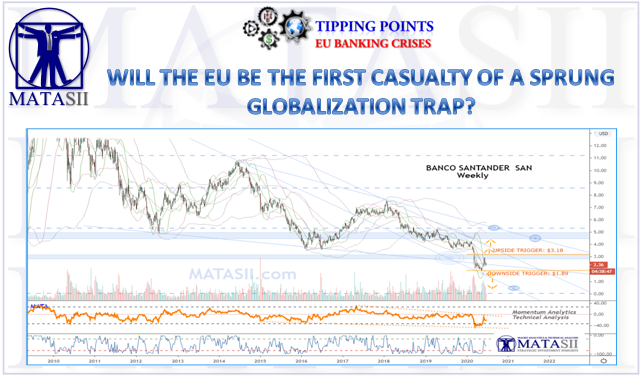TIPPING POINTS
EU BANKING CRISIS II
- SUPPLY/DEMAND: PLUNGING WORLD TRADE
- World trade in goods plunged by 12% in April from March, after having already dropped 2.4% in March from February. This plunge of the Merchandise World Trade Monitor, released by CPB Netherlands Bureau for Economic Policy Analysis, was by far the largest month-to-month drop in the history of the data going back to 2000. Compared to April last year, the index was down 16.2%.
- World trade had already taken a hit starting in late 2018, as tariffs, counter-tariffs, and threats of tariffs jiggled supply chains around. By December 2018, the index was down 1.2% from a year earlier. Year-over-year declines became a regular feature starting in June 2019. Then in March, the index dropped 5.4% year-over-year, and in April 16.2% year-over-year. This brought the index down 18% from the peak in October 2018, and back to where it first had been in January 2008.
- DEMAND: PLUNGING IMPORT TRADE
- In the US, trade took an even bigger hit, with exports of goods collapsing 25% in April from March and 30% year-over-year, according to the Commerce Department earlier in June. Imports plunged 13.6% in April from March, and 20.2% year-over-year. For the first four months of 2020, US imports from China plunged 24% year-over-year .
-
On June 25, the Commerce Department released its advance estimates for May, which showed further deterioration in both exports and imports:
- Exports in May dropped 5.7% from April and collapsed by 35% year-over-year, to just $90.1 billion, the lowest amount of exports since August 2009, and down 37% from the peak in 2018.
- Imports in May dropped 1.8% from April and 23.6% year-over-year to $164.4 billion, the lowest since July 2010. This was 25% below the peak in 2018.
- The slow-down in the US goods-based sectors started in late 2018 and worsened in 2019 before getting walloped in 2020.
-
Bloomberg reported that: “The European Union moved closer to recommending that travelers from the U.S. shouldn’t be allowed to enter the bloc even after July 1.” In this context, “European diplomats are braced for President Donald Trump to take unkindly to Americans being kept away, while the Chinese are allowed in.
- According to Bloomberg: “Transatlantic relations could reach a new low next month as the European Union readies tariffs on billions of dollars of American exports aimed at politically important industries for President Donald Trump and his Republican allies in Congress. The EU has asked the World Trade Organization to give it the green light to place levies on $11.2 billion of U.S. products over a long-running aircraft subsidies dispute. A ruling is expected as soon as July and the EU is planning to target coal producers, farmers and fisheries, in addition to the makers of aircraft and parts.”
FAIR USE NOTICE This site contains copyrighted material the use of which has not always been specifically authorized by the copyright owner. We are making such material available in our efforts to advance understanding of environmental, political, human rights, economic, democracy, scientific, and social justice issues, etc. We believe this constitutes a ‘fair use’ of any such copyrighted material as provided for in section 107 of the US Copyright Law. In accordance with Title 17 U.S.C. Section 107, the material on this site is distributed without profit to those who have expressed a prior interest in receiving the included information for research and educational purposes. If you wish to use copyrighted material from this site for purposes of your own that go beyond ‘fair use’, you must obtain permission from the copyright owner.
NOTICE Information on these pages contains forward-looking statements that involve risks and uncertainties. Markets and instruments profiled on this page are for informational purposes only and should not in any way come across as a recommendation to buy or sell in these assets. You should do your own thorough research before making any investment decisions. MATASII.com does not in any way guarantee that this information is free from mistakes, errors, or material misstatements. It also does not guarantee that this information is of a timely nature. Investing in Open Markets involves a great deal of risk, including the loss of all or a portion of your investment, as well as emotional distress. All risks, losses and costs associated with investing, including total loss of principal, are your responsibility.

